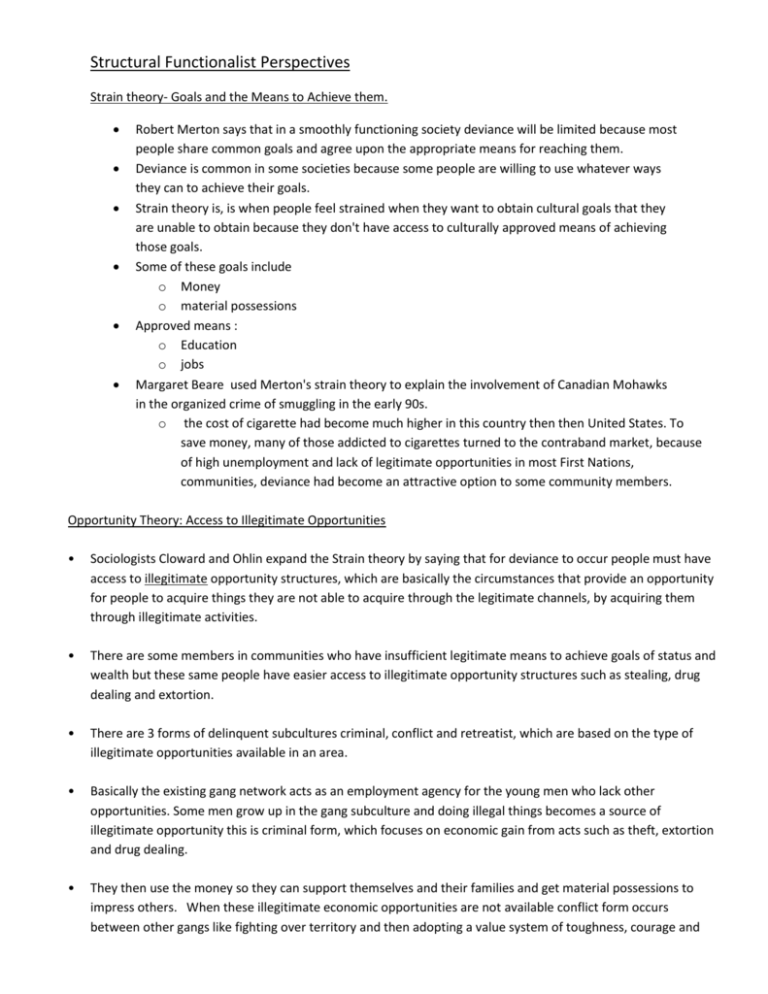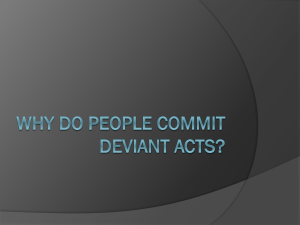Perspectives on Crime
advertisement

Structural Functionalist Perspectives Strain theory- Goals and the Means to Achieve them. Robert Merton says that in a smoothly functioning society deviance will be limited because most people share common goals and agree upon the appropriate means for reaching them. Deviance is common in some societies because some people are willing to use whatever ways they can to achieve their goals. Strain theory is, is when people feel strained when they want to obtain cultural goals that they are unable to obtain because they don't have access to culturally approved means of achieving those goals. Some of these goals include o Money o material possessions Approved means : o Education o jobs Margaret Beare used Merton's strain theory to explain the involvement of Canadian Mohawks in the organized crime of smuggling in the early 90s. o the cost of cigarette had become much higher in this country then then United States. To save money, many of those addicted to cigarettes turned to the contraband market, because of high unemployment and lack of legitimate opportunities in most First Nations, communities, deviance had become an attractive option to some community members. Opportunity Theory: Access to Illegitimate Opportunities • Sociologists Cloward and Ohlin expand the Strain theory by saying that for deviance to occur people must have access to illegitimate opportunity structures, which are basically the circumstances that provide an opportunity for people to acquire things they are not able to acquire through the legitimate channels, by acquiring them through illegitimate activities. • There are some members in communities who have insufficient legitimate means to achieve goals of status and wealth but these same people have easier access to illegitimate opportunity structures such as stealing, drug dealing and extortion. • There are 3 forms of delinquent subcultures criminal, conflict and retreatist, which are based on the type of illegitimate opportunities available in an area. • Basically the existing gang network acts as an employment agency for the young men who lack other opportunities. Some men grow up in the gang subculture and doing illegal things becomes a source of illegitimate opportunity this is criminal form, which focuses on economic gain from acts such as theft, extortion and drug dealing. • They then use the money so they can support themselves and their families and get material possessions to impress others. When these illegitimate economic opportunities are not available conflict form occurs between other gangs like fighting over territory and then adopting a value system of toughness, courage and status enhancing qualities. Those who lack ability to join these gangs may turn to drinking or drug use which is the retreatist form of delinquent subculture. • Opportunity theory expands Strains theory by pointing out the relationship between deviance and the availability of illegitimate opportunity structures. Gang membership may provide some people in low-come central city areas with illegitimate means to acquire protection, money entertainment and refuge. Control Theory Importance of social bonds to the understanding of deviant behavior Anomic suicide occurs when a lack of social regulation, caused by factors such as rapid economic change This creates a situation in which social organizations are weak Gang members may bond with one and other rather than with persons who subscribe to dominant cultural values. Social bond theory holds that the probability of deviant behavior increases when a person’s ties to society are weakened or broken Social bonding consists of : 1) attachment to other people 2) Commitment to conventional lines of behavior, such as schooling and job success 3) Involvement in conventional activities and 4) belief in the legitimacy of conventional values and norms. Structural Functionalist Perspectives Differential Association Theory A functionalist theory developed by Edward Sutherland in 1939. Definition- Individuals are more likely to deviate from societies norms when they frequently associate with people that would rather deviate than conform to society. Differential association theory contributes to our knowledge of how deviant behavior reflects on individual’s learned techniques, values, attitudes, motives and rationalization from our long lasting and close relationships. Group encouragement of deviance supports peers in recruiting and going against norms. Ex: body piercings, vandalism, and punk music. This theory does not include possible linkages between social inequalities and criminal behavior. Labelling theory (Symbolic Interactionist) Deviants are people who have been successfully labeled that way o i.e. Someone says you are bad, so you act badly Usually a person in power or authority applies the label and it is so often applied that the person comes to accept it and believe it Often depends on the person’s character, family, social standing o i.e rich, smart, white are less likely to be labeled deviant for shoplifting than poor, nonwhite peer Primary deviance-actual breaking of law Secondary deviance-accepts deviant label and continues to break law Primary deviance →label causes stigmatization →deviant self-image →secondary deviance Moral entrepreneurs-people who take active role in getting certain behaviours labeled deviant i.e. MADD, people moral crusades-public and media campaigns led by moral entrpreneurs The conflict approach: The critical approach is based on the assumption that the criminal justice system protects the power and privilege of the capitalist class. The laws were motivated by fear of losing power rather than by real concern with criminal behaviour Why do people commit crimes? o Rich people are greedy and want more than what they have, but also commit crime to survive, avoid poverty. o According to critical theorists the poor commit crime to survive. o They find they can’t afford the necessary essentials, such as food, clothes and shelter. The way laws are written and enforced benefits the capitalist class by ensuring that individuals at the bottom of the social class structure do not infringe on the property or threaten the safety of those on top. People of all classes commit crimes, for example do laws that prohibit murder, rape and armed robbery not only protect middle and upper class but also low class people. While some laws only protect the rich and powerful, some laws protect everyone. Postmodern Perspective on Crime Power, knowledge and social control are intertwined KNOWLEDGE IS POWER Different ways of imposing social control which may at first seem more humane, but really violate individual rights far more than traditional methods Eg. Cameras in school, observation post in prison-students/inmates may be watched at anytime, only administrators are those in power have knowledge of when behavior is actually being observed Michael Foucault thought that new surveillance on prisons gave more power to prison officials, not necessarily putting an end to the torture era.






